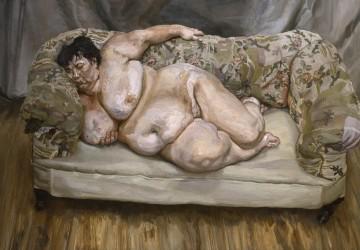
Benefits Supervisor by Lucian Freud. At the National Portrait Gallery.
David Shrigley is funny. Very, very funny. He has an odd way of taking things that are very ordinary and making them seem absolutely ridiculous – eggs, for example – or vice versa: taking the absurd or ununsual, e.g. sculpture, and rendering it quotidian.
It’s not exactly that he has a weird mind, it’s more that his mind is exactly in tune with everyone else’s, except that he notices things that others don’t – or, rather, he thinks that small, unnoticeable things are worth commenting on.So I was very much looking forward to seeing his show at the Hayward Gallery, which is on at the moment. And guess what? It’s funny. He’s a conceptual artist, or a childish cartoonist (or both) – but the things that work best, I think, are the least conceptual, the times when he has just had a thought, or perhaps caught a fraction of a sentence, and illustrated that thought or scrap of conversation. I thought they were the best thing in the show: funny, irreverent, profound and silly. There’s one that says something along the lines of: It’s ok to run away from your problems; it’s a good idea. Hilarious. And kind of true.Unfortunately, the very tall man in the green fleece standing next to me didn’t feel the same way. He was gazing at each picture – and, yeah, they’re art but they’re also basically funny drawings (is there a conflict there? I don’t see why, particularly) – as though each one has the intricacy of a Hieronymus Bosch. And he didn’t look kindly on my giggling.
‘Don’t you think they’re funny?’ I said, eventually.
‘They’re art,’ he said, censoriously. ‘But I suppose everyone has their own sense of humor.’
Told.
No laughing, then, at the press preview for the enormous and wonderful Lucian Freud show at the National Portrait Gallery.
Now this is one helluva show. Boy oh boy is there a lot to see – and wow it’s good. What one notices, seeing the pictures up close like this, is how brilliant, beautiful and delicate the hands are – particularly in the earlier work, in the 60s, where you can see the curve of each nail and the close-ups of every cuticle; the roughness of skin on knuckles and the veins, either greenish or bluey, on the backs. And the faces are so expressive, too. Not so much in the pictures of Kitty Garman (his first wife), but by the time he gets to Caroline Blackwood (his second) it seems as though he has unlocked something in himself and they are extremely powerful – first laden with innocent loveliness and then, later, with scorn.
Throughout, the paint itself looks sticky and peaked – like tacky half-dried bodily fluids. The nude portraits are peculiarly, disquieteningly sexy – almost coldly objective, yet one could nearly reach out and touch the warm skin. Somehow, the paintings of two people together are the most moving in the show. Perhaps this is because they bring the subject out of pure objectivity (as a subject, seen and viewed) and back into their human life with its interactions, quibbles and love and the need for companionship. They move from the stasis and momentary glimpse of life that the single portraits (or at least the less good of the single portraits) are and into movement and dialog. Which all goes a long way to heighten their pathos.
This is an edited version of a post that first appeared on Violet Hudson’s blog

